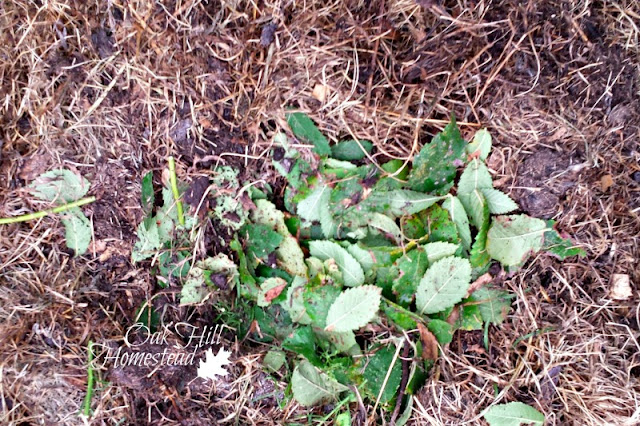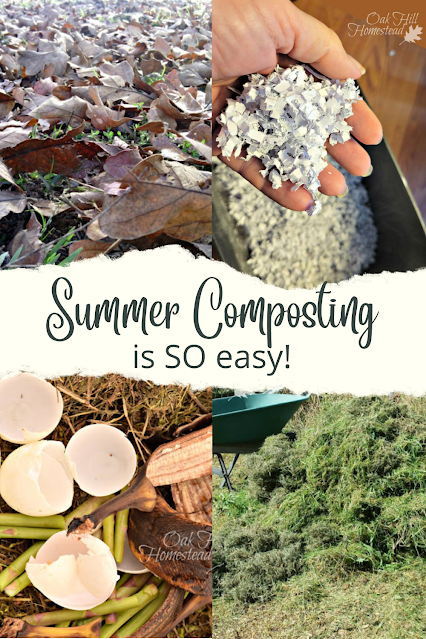Spring and summer are the ideal time to begin composting. Grass and weeds from your lawn and garden are the perfect ingredients to start a new compost pile. Learn how to begin composting in this post.
How to build a compost pile
Several years ago I began composting in earnest.
Before that, I'd done it in a haphazard, small-scale fashion. When I enlarged my garden and needed to fill those new raised beds, my homegrown compost was the best way to go, so I got serious about composting.
This post contains affiliate links. Read my full disclosure here.
In order to fill a a new raised bed, I purchased bags of "compost" and top soil from one of the big box stores.
The compost had recognizable chunks of wood in it, which in my mind means it wasn't completely finished compost. I was quite disappointed in it.
My own homemade compost is so much nicer. But I didn't have very much of it, so I had to make the best of things.
And that's when I began composting more seriously and on a larger scale.
For more even more information on starting a new compost pile, check out my composting for beginners post here.
Winter composting is harder
I've discovered that it's much harder to compost over the winter. I know people do it, but the cold weather really slows down my compost pile.
So while I continue to add my kitchen waste deep in the existing pile, basically I wait for spring and warmer weather.
There are ways to encourage your compost to keep working over the winter though, if you don't mind being outdoors and putting in some time.
Composting in summer is easy
But composting in summer is so easy. Summer temperatures make it easy for the compost pile to reach and maintain a high internal temperature for successful composting.
Simply put, composting is the art of mixing nitrogen ("green") and carbon ("brown") ingredients and letting them rot.
If you never touch the pile again it will eventually turn itself into compost, but you can hurry up the process with a few tricks.
How to speed up the composting process
Chopping your ingredients into small pieces will help hurry the process along.
- Sticks and branches can take years to break down, so you'll do better if you can run them through a wood chipper.
- Tear cardboard into small pieces.
- Run paper through your paper shredder. We recently bought a new paper micro-cut shredder that cuts paper into confetti-sized pieces that break down fast in the compost pile.
- Rake up all those autumn leaves and save them until spring. I pile them all in a water trough that sprung a leak years ago and let them sit all winter. Use your lawnmower to chop them into smaller pieces.
Kitchen scraps
Sometimes I have a large bowl full of watermelon rind or apple peels, but more often I have a little bit of this or that destined for the compost pile.
I add them to a gallon-size plastic zipper bag and store them in the freezer until the bag is full, then I take it out to the compost pile.
Bonus: freezing food scraps helps your kitchen waste break down faster when added to your compost bin!
Moisture
Your pile also needs moisture.
Oklahoma in summer is a bit light on moisture - unless you're measuring the humidity in the air - so when I water the garden, I stick the hose inside the compost pile and apply a generous amount of water.
When turning the pile or layering new ingredients, I water each layer.
I've never had a pile that was too wet, but that might be attributed to my weather and summer temperatures.
Microbes
A few shovelfuls of regular soil will give your compost pile the microbes needed to start decomposing those raw ingredients.
You can also give your compost pile a jumpstart with a layer of comfrey leaves if you have them. Just layer them in with the rest of your ingredients. Comfrey breaks down very quickly and is an excellent compost accelerator.
Oxygen
Turning your pile about once every week or two will add oxygen and speed up the composting process.
A typical compost pile
A typical homestead compost pile might contains layers of:
- horse manure and straw
- autumn leaves
- grass clippings
- shredded paper
- weeds pulled from the garden
- goat manure mixed with spilled hay
- bedding from the chick brooder and chicken coop
- kitchen waste (eggshells, coffee grounds, tea bags, fruit and vegetable waste, etc)
If you don't have livestock, your compost pile might not include manure, but you can still compost successfully. Don't let the lack of manure stop you - it isn't a required ingredient.
Make the layers in your compost pile rather thin. Divide all the grass clippings into four or more layers with leaves or other dry material in between.
Be sure to bury your food scraps and kitchen waste deep in your pile to help keep animals from digging.
Occasionally I have a critter dig them up during the night. I just thank them for turning my compost pile for me and shovel it all back together.
The composting "trick"
Successful composting relies on a combination of green and brown ingredients plus moisture plus oxygen.
The secret to composting is adding the right balance of "brown" and "green" ingredients. Some sources say you need a ratio of four parts brown to one part green. Others say half and half works. I've discovered that it just depends on what you're using.
Some ingredients are wetter than others and the ratio is never absolute.
Just toss your stuff in there, and if the pile is too wet, add more brown (carbon) items to soak up the moisture; if it's too dry, add more green ingredients. If your compost pile is directly on the ground, any excess moisture runs right off.
Finding enough "brown" ingredients
If you're light on "brown" (carbon) ingredients, spread out your grass clippings in a very thin layer on the ground until they dry out. Now they are a source of carbon instead of nitrogen.
Rake all those fallen leaves in autumn into garbage bags or boxes and save them until you need them.
I've discovered a new source of "brown" ingredients too!
Shredded paper, while a good source of carbon, mats together and forms a compacted layer that doesn't decompose quickly.
We recently had to replace our old paper shredder, so I bought a micro-cut paper shredder to replace it. Now, instead of long strips of paper that mat together, I have little pieces that resemble confetti. And it behaves so much better in my compost pile!
What if you don't have enough compost materials?
If you're worried that you won't have enough compost materials for a successful compost pile - or you have plenty of greens but not many browns (or vice versa) - you'll find some tips and ideas for finding free compost materials in this post.
Is your compost pile working?
How do you know if your compost pile is working? Dig down into the pile to add kitchen waste, and you'll notice that it's hot inside.
When you turn the pile, you might notice that the inside looks like it's been burned or charred, and you might even see steam rising.
The easiest way to know your compost pile is working is to use a compost thermometer such as this one so you can measure the exact temperature.
How to tell your compost pile is "finished"
You'll know your compost is finished by the appearance - it will look like rich, crumbly earth, and smell earthy.
You can sieve your compost through a wire screen with holes about 1"x1" - and add any larger pieces that haven't completely broken down to your next compost pile to decompose further.
Voilà! You've made compost! It's much nicer than the bags from the store, and it was completely free.
You recycled garden waste, kitchen waste, office waste, and barn waste into something that is great for your garden, and this is waste management at its best.
Plus you had a great cardio workout every time you turned the pile without having to pay for a gym membership.
Are you still on the fence about starting your own compost pile? Here are four more reasons why you should be composting.
Are you ready to learn more about composting and get started on a program of your own? Find out how in my new ebook The Down-to-Earth Guide to Composting.
I'll show you in plain, simple terms how to start your compost pile, demystify that "magic ratio" of greens to browns that everyone talks about, help you troubleshoot your compost pile if needed, and give you a crazy-long list of what you can and what you shouldn't compost.
You'll find more information here.
~~~~~
Facebook | Instagram | Pinterest | Subscribe









.jpg)











